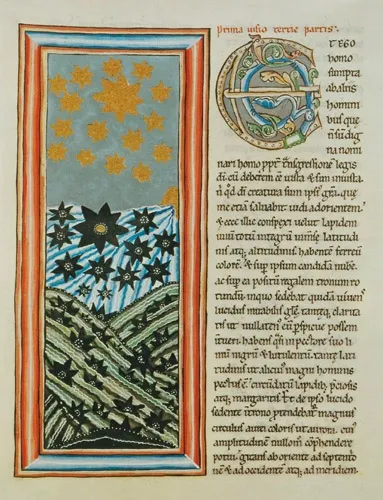Reference to Hildegard's Works:
Scivias III.1 (Hart & Bishop, pp. 308-321)
Click play to listen to audio description:
The vision of the Fallen Stars is an image some find confusing on a sanctuary wall. It tells the story of the fall of Lucifer, the once brightest and most decorated of all the angels. The name translated means, “lightbearer.” According to St. Hildegard, God adorned Lucifer with the most beautiful of all the gemstones but he became so enamored with his own light that he turned his gaze away from God towards himself (pride, ego) and subsequently fell from grace. This story is on some level a prefiguring of the story of the fall of humanity (as it is told in the story of Adam and Eve in the first few chapters of the Book of Genesis). It is quite common to find images of Adam, Eve, the Tree of Life, and the notorious snake depicted in Catholic Churches. Through that lens, the image of the Fallen Stars is equally appropriate.
The church building where the Community of St. Hildegard gathers was built in 1926 by members of the Byzantine Catholic Diocese and was dedicated to St. Michael the Archangel. Overlooking the sanctuary in the adjacent loft is a beautiful stained glass valiant image of St. Michael with his wings extended and sword drawn, standing on what looks like a man. In the tradition, St. Michael battled the fallen angels, and in particular Lucifer, who was banished from the heavens.
In this vision of the Fallen Stars, St. Hildegard wrote the following:
“And from this Shining One seated upon the throne extended a great circle colored gold like the dawn, whose width I could not take in; it circled about from the East to the North and to the West and to the South, and back toward the East to the Shining One, and had no end. And that circle was so high above the earth that I could not apprehend it; and it shone with a terrifying radiance the color of stone, steel, and fire, which extended everywhere, from the heights of Heaven to the depths of the abyss, so that I could see no end to it. And then I saw a great star, splendid and beautiful, come forth from the One seated on the throne. And with that star came a great multitude of shining sparks, which followed the star toward the South, looking on the One seated on the throne like a stranger; they turned away from Him and stared toward the North instead of contemplating Him. But, in the very act of turning away their gaze, they were all extinguished and were changed into black cinders. And behold, a whirlwind arose from those cinder, which drove them away from the South, behind the One sitting on the throne, and carried them to the North, where they were extinguished. I saw the light, which was taken from them, immediately return to Him Who sat on the throne.”
We live in a world marked by so much darkness. However, we did not originate in darkness. We came from light, from the Living Light. St. Hildegard’s vision of the fallen stars reminds us that God’s love is so great that we have been given the gift of free-will. Not only is this gift bestowed on human beings, but on the angelic world as well. In the Book of Revelation, St. Michael leads an army of light against this legion of darkness. This image on our sanctuary wall serves to motivate us to strive to live in the light. While recognizing that we live in a fallen world, we commit ourselves each liturgy to embraces the path of light, love, and peace. The good news of our faith is that regardless of how far we fall into the depths of darkness, the path upwards towards the light is always possible, if we choose to follow it. There is always a spark of divine light burning within us waiting to be rekindled.
For Ash Wednesday each year we mix a bit of “stardust” into our ashes and pray the words, “You are stardust and unto stardust you shall return.” We literally came from the light and unto the light we are called to return.
The image of the Fallen Stars on the sanctuary wall was created by our founding pastor, Rev. Dr. Shanon Sterringer while on sabbatical in 2019. Since that time, several members of the community have contributed their gifts and talents to this theme. For example, the altar cloth was created by Clarice Leonard and a matching stole by Deborah Linn. We are children of the light. May this image inspire us to always strive to radiate Christ’s Light.
To look up additional information on our art pieces, or find a bibliography, please click here to view our resources page.




